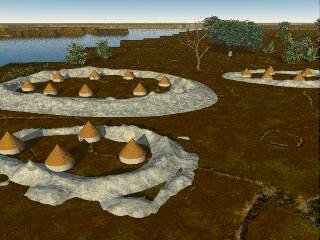Gary C Daniels | Lost Worlds | January 31 2012

Six hours southeast of Atlanta off the Georgia coast on Sapelo Island, archaeologists have unearthed the remains of an ancient walled city which predates the construction of Egypt’s pyramids. Known as the Sapelo Shell Ring Complex, this ancient city was constructed around 2300 B.C. and featured three neighborhoods each surrounded by circular walls twenty feet in height constructed from tons of seashells. Some of the earliest pottery in North America was also found buried in the remains of this lost city.
The site is quite an enigma because at the time of its construction the Native Americans living in the area were simple hunters and gatherers who had yet to invent agriculture. Many scholars believe agriculture is a prerequisite for civilization. Did these simple tribal people somehow make the leap from hunting-and-gathering to civilization in a single bound producing not only a walled city but also the new technology of pottery without the benefit of agriculture? Or did an already civilized people arrive on the coast of Georgia from elsewhere and, if so, where did they come from and why?
Just thirty years before the construction of the Sapelo Shell Rings researchers have noted that Bronze Age civilizations around the world show a pattern of collapse. According to the article “Sapelo Shell Rings (2170 BC)“:
In the Middle East, Akkadian Sumer collapsed at this time and the Dead Sea water levels reached their lowest point. In China, the Hongsan culture collapsed. Sediments from Greenland and Iceland show a cold peak around 2200 BC. The population of Finland decreased by a third between 2400 and 2000 BC. In Turkey’s Anatolia region, including the site of ancient Troy, over 350 sites show evidence of being burnt and deserted. Entire regions reverted to a nomadic way of life after thousands of years of settled agricultural life. In fact, most sites throughout the Old World which collapsed around 2200 BC showed unambiguous signs of natural calamities and/or rapid abandonment.
What happened around 2200 B.C. that could have caused such widespread devastation?
